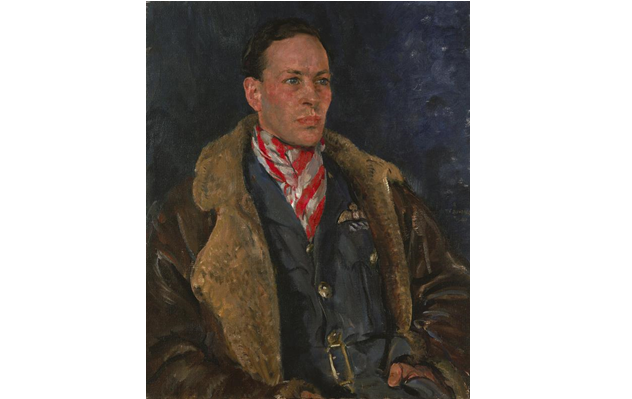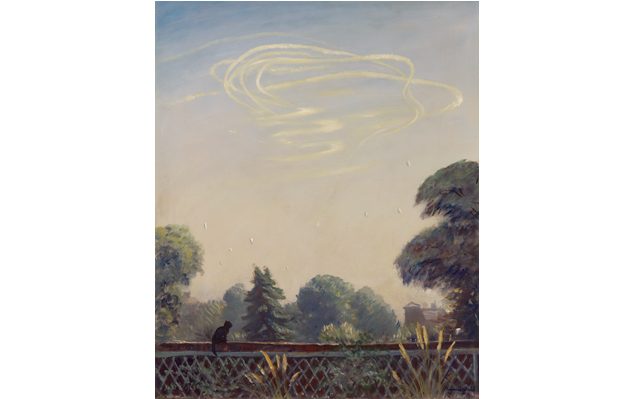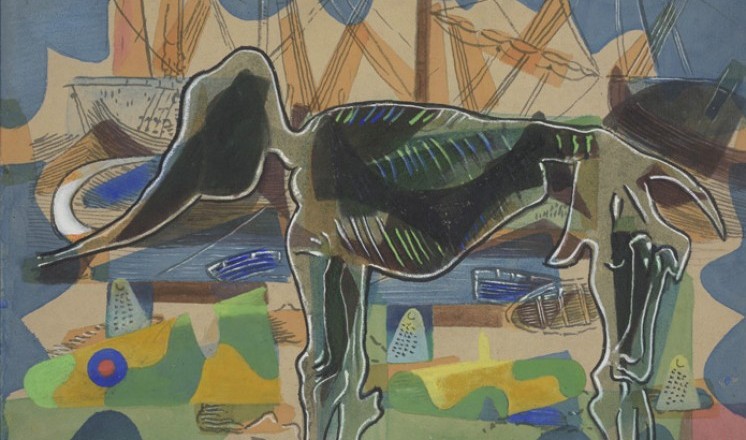Online Exhibition Learning Project
RSS FeedThis collaborative digital Exhibition Learning Project explores, interprets and responds to a selection of art works that reflect upon the 80th anniversary of the Battle of Britain in 2020.
For the project in 2020, we brought together works from the Imperial War Museum and our own collection at The Collection and Usher Gallery to digitally showcase and explore the huge variety of art work made during the Second World War to mark this tremendous event in British aviation history. Over 8 weeks, we added weekly links from this page to online projects and learning resources all created by the Investigate Learning Team in response to these selected art works.
For the Battle of Britain Anniversary on 15th September 2021, we are making all of the resources available once more on our website and also digitising parts of our collection including works donated by the War Artists Advisory Committee after the Second World War.
On the 15th September 2021, we will be joining the IWM for their Twitter Takeover day and sharing images and resources developed from this project along with the other partners.
Available Online Content:
- Find out more about the central three loaned art works from the Imperial War Museum below.
- An Online Curatorial Project created by the Creative Collective, our young peoples group, launched in January 2021. Visit the website to see creative and curatorial reflections on the selected works, including essays, films, a podcast and an audio play: https://flyingintoaction.com/
- An online film and drama workshop looking at World War Two produced by Aviation Learning and Rhubarb Theatre for children, teachers and homeschoolers.
- Online poetry workshop created by local poet Ash Dickinson, based on the Battle of Britain, using some of the paintings from the exhibition as his inspiration. Learn how to write a "Nonet" and get the opportunity to compose one of your very own. Watch the video here.
- Step back in time to September 1939 with aviation historian Brian Riley and hear the story of The Battle of Britain, from the start of hostilities with Germany invading Poland right through to Hitler being forced to change his mind about attacking England in September 1940. Learn about the importance of radar and how this helped the RAF plan their attacks and protect their aircraft; Hitler's big mistake leading to the biggest loss of German aircraft in one day; the important role played by the British allies in helping the RAF and how the tiny fleet of fighter planes outmanoeuvred the mighty Luftwaffe.
- We wanted to show you behind the scenes in our new Exhibition Learning Project film. Collaborating with both the Imperial War Museum and our Creative Collective for this project has been really exciting and we are showcasing, in the first of our two project films, how we brought the digital interpretation to life! Click here to watch this video.
- Film showcasing the final results of the Exhibition Learning Project with input from Liz and Paris from the IWM. Click here to watch the video.
This Online Exhibition Learning Project was initiated by the Learning and Exhibitions Teams at The Collection Museum, with support from The Mighty Creatives, Arts Council and the Imperial War Museum Battle of Britain Partnership.
Working together to provide learning experiences are:
- The Investigate Learning Team and Exhibition Team of Lincolnshire County Council
- The Creative Collective of The Collection Museum and Usher Gallery
- Paradigm Arts
- The Investigate Aviation Learning team, as part of the Arts Council Museums and Schools Project and in collaboration with the Aviation Heritage Lincolnshire Partnership.
The Imperial War Museum Battle of Britain partnership project was made possible with Art Fund support. The aim was for three Battle of Britain artworks to be displayed at four distinctive venues throughout 2020, alongside unique works from each of the partners' collections, each display exploring and illustrating a different, locally-relevant perspective on Second World War aviation. Due to the restrictions caused by the Covid-19 pandemic, our physical exhibition and learning project was cancelled but now exists entirely online.
More information about this partnership programme can be found here.
Art.IWM ART 17748
Untitled, c.1940
By Eileen Agar
Gouache on board
© The Estate of Eileen Agar / Bridgeman Images
About the artist
Eileen Agar was born in Buenos Aires, Argentina, and moved to Britain in 1911. She attended the Slade School of Art before studying in Paris, eventually settling in London in 1930. Agar was one of the few female artists selected for the ground-breaking ‘International Surrealist Exhibition’ in London in 1936. During the Second World War, she worked in a canteen in Savile Row by day and served as a fire watcher by night. Agar struggled to work on her painting during this period exclaiming in her writings, ‘How does one communicate with any subtlety when the world is deafened by explosions?’
About the image
An outline reminiscent of a prehistoric mammoth dominates the foreground of this painting. Ships’ masts and rigging, small boats and shell-like shapes can be seen in the background alongside camouflaged RAF aircraft wings. The overall composition is framed by wavy blue shapes, perhaps in reference to the sea surrounding the island of Britain. This Surrealist painting fuses both natural and man-made elements, and old and new, to bring together land, sea and air.
History
During the summer and autumn of 1940, the pilots of RAF Fighter Command, flying iconic aircraft including the Hurricane and Spitfire, defended the skies over Britain against the German Luftwaffe during the Battle of Britain. This major air campaign was fought above southern England, over stretches of coastline which Agar frequented on holiday with fellow artists and friends. Agar’s retreat was now under severe threat.
Art.IWM ART LD 783
Squadron Leader G L Denholm, DFC, 1940
By Thomas Cantrell Dugdale
Oil on canvas
About the artist
Thomas Cantrell Dugdale was born in Blackburn, Lancashire and studied in Manchester, London and Paris. During the Second World War, he served as a platoon leader for the Home Guard in Suffolk and was commissioned by the War Artists Advisory Committee to produce portraits of notable servicemen and women.
About the image
This portrait depicts Squadron Leader George Lovell Denholm, nicknamed ‘Uncle’, who flew Spitfires during the Battle of Britain. He led No. 603 Squadron which had been redeployed from its base in Edinburgh to RAF Hornchurch in August 1940 to take part in operations over southern England. Despite being shot down twice, Denholm returned to the skies and was awarded the Distinguished Flying Cross (DFC) for his service. His citation in the London Gazette on 22 October 1940 reads:
“Since the commencement of hostilities, Squadron Leader Denholm has led his squadron, flight or section in innumerable operational patrols against the enemy. His magnificent leadership has contributed largely to the success of the squadron, which has destroyed fifty-four enemy aircraft in about six weeks; four of these aircraft were destroyed by Squadron Leader Denholm himself.”
Denholm is shown wearing a leather flying jacket and red and white striped cravat. His jacket falls open to reveal his newly-acquired DFC ribbon bar above his left breast pocket.
History
Nearly 3,000 RAF servicemen took part in the Battle of Britain. While most of the pilots were British, many came from all over the Commonwealth and occupied Europe - from Poland, New Zealand, Canada, Czechoslovakia (now Czech Republic and Slovakia), Belgium, Australia, South Africa, France, Rhodesia (now Zimbabwe), Barbados and Jamaica. There were even some pilots from neutral Ireland and the United States (before the US joined the war in 1941).
Art.IWM ART LD 485
An Aerial Battle, 6 September 1940
By Francis Dodd
Oil on canvas
About the artist
Francis Dodd was born in Holyhead in Anglesey, Wales. He studied at the Glasgow School of Art where he was awarded a travelling scholarship, venturing to France and Italy. He was commissioned as a war artist in both the First and Second World Wars and became a member of the Royal Academy in 1935. He lived in Blackheath, London, until his death in 1949.
About the image
In this scene, a black cat sits on a garden wall seemingly unaware of the recent aerial dogfight which has taken place in the skies above. The aircraft themselves are not visible but their weaving white contrails reveal the tight manoeuvres made between the RAF Fighter Command and German Luftwaffe. Dodd’s scene conveys the simultaneous proximity and distance of the Battle of Britain; aerial combat is evident in the sky but life goes on below.
History
The RAF pilots who fought during the Battle of Britain were supported by thousands of servicemen and women on the ground. In this painting, numerous barrage balloons are shown floating above the trees. Operated by RAF Balloon Command, barrage balloons were used to protect cities from air attack. They forced German aircraft to operate at higher altitudes, reducing the accuracy of their bombing and bringing them within range of anti-aircraft guns.
Comments
There aren’t any comments for this blog yet



